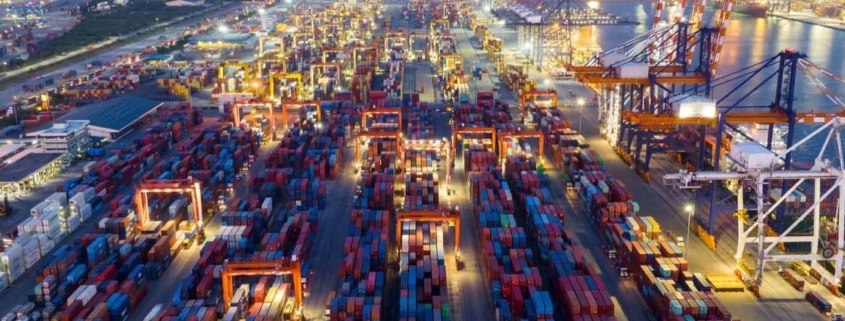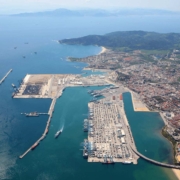How Did the Global Port Sector Perform in the First Half of 2025?
The first half of 2025 delivered positive numbers for much of the international maritime trade. According to the latest report from Alphaliner, the world’s Top 30 container ports showed solid performance, with a notable recovery on the U.S. West Coast, rapid growth across Asia and India, and early signs of improvement in Europe.
Below, we break down the main trends and results that shaped the port sector from January to June 2025.
U.S. West Coast: Back in the Spotlight
The Los Angeles/Long Beach (LA/LB) port complex had its best first half since 2022, with year-over-year growth of 7.5%, reaching 9.7 million TEUs. Reduced congestion and the Red Sea crisis helped it gain ground over the East Coast.
Meanwhile, New York/New Jersey (NY/NJ) handled 4.4 million TEUs, a 4.9% increase. Although both coasts saw a July surge due to potential tariff threats, LA/LB outpaced its Atlantic counterparts in growth rate.
Asia Leads the Charge: Strong Growth in China, Malaysia, and India
Malaysia
Tanjung Pelepas Port recorded the highest percentage growth among the Top 30, with a 15.4% increase. Operated by PTP (MMC Corp + APM Terminals), the terminal has become a hub for the new Gemini Cooperation alliance, now handling 60% of its total volumes.
India
Jawaharlal Nehru/Nhava Sheva Port grew by 15.2% to 3.87 million TEUs, driven by the opening of Phase 2 at Bharat Mumbai Container Terminals (BMCT), which added 2.4 million TEUs of capacity.
Mundra Port has yet to publish Q2 figures, but its operator, APSEZ, reported a 20% year-on-year increase.
China
China maintained its global lead with 170 million TEUs moved in six months, growing 6.9% despite U.S. tariffs of up to 145%.
- Shenzhen led national growth (+10.8%)
- Ningbo-Zhoushan also performed strongly (+9.9%)
- Shanghai remains the world’s busiest port (27 million TEUs, +6.1%)
Together, China’s top 10 ports accounted for over half of the total volume in the Top 30.
Europe: Signs of Recovery After Difficult Years
Hamburg Port (Germany) saw a 9.3% increase, moving 4.2 million TEUs after years of decline. Growth was driven by trade with the Far East (+10.7%) and the Baltic Sea (+20.8%). The port also saw an uptick in large vessel calls:
- Vessel calls over 10,000 TEUs: +50%
- Vessels over 24,000 TEUs: +30%
Antwerp-Bruges (Belgium) climbed the rankings, overtaking Hong Kong for the first time, thanks to 3.7% growth.
Declines: Hong Kong and Kaohsiung Lose Ground
Despite widespread growth, some ports continued to slip:
- Hong Kong fell 3.4%, dropping from 11th to 15th place
- Kaohsiung (Taiwan) declined 2.2%
Both ports have seen a steady decline in relevance compared to more modern or better-connected regional competitors.
Ranking: Top 10 Container Ports – First Half of 2025
| Rank | Port | Country | TEUs (M) | Growth % |
| 1 | Shanghai | China | 27.06 | +6.1% |
| 2 | Singapore | Singapore | 21.71 | +7.2% |
| 3 | Ningbo-Zhoushan | China | 21.05 | +9.9% |
| 4 | Shenzhen | China | 17.23 | +10.8% |
| 5 | Qingdao | China | 16.38 | +7.8% |
| 6 | Guangzhou | China | 13.64 | +7.7% |
| 7 | Busan | South Korea | 12.68 | +3.5% |
| 8 | Tianjin | China | 12.25 | +3.1% |
| 9 | Los Angeles/Long Beach | USA | 9.70 | +7.5% |
| 10 | Dubai | UAE | 7.77 | +6.0% |
A Semester of Recovery and Strategic Realignment
The first half of 2025 confirms a global reconfiguration of maritime trade:
- The U.S. West Coast ports are regaining strength
- China and Asia are solidifying their leadership
- Europe is beginning to bounce back after years of decline
Adaptation to new trade routes, the search for greater efficiency, and the influence of geopolitical factors—like tariffs and the Red Sea crisis—are reshaping the global logistics map.
Want to stay updated on maritime trade and port trends?
Visit our blog and get the most comprehensive insights on ports, logistics, and global transportation.









